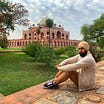This week marks the arrival of Holi, India’s most colourful festival.
It signals the arrival of spring celebrates the victory of good over evil and is probably Indias most famous festival abroad. But it is also one of India’s most ancient festivals, and evidence of spring 'colour festivals' go back thousands of years.
Today, we’re tracing the origins of …
Keep reading with a 7-day free trial
Subscribe to Travels of Samwise to keep reading this post and get 7 days of free access to the full post archives.





